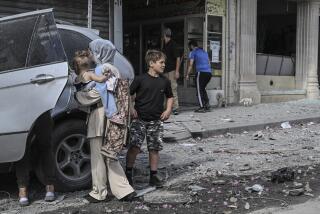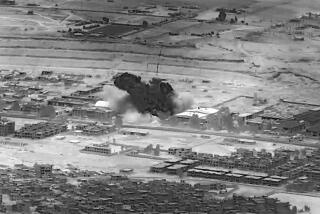Reality Check -- This Is War
- Share via
The panic gripping Washington over the state of Iraq makes it clear we have been spoiled by the seemingly easy, apparently bloodless victories of the last decade. From the Persian Gulf War of 1991 to the Afghanistan war of 2001, we got used to winning largely through air power. There were casualties, of course, but few of them were on our side. In Kosovo, we managed to prevail without losing a single person. We forgot what real war looks like. Iraq is providing an unwelcome reminder of how messy and costly it can be.
By comparison with the wars of the last decade, what’s happening in Iraq appears to be a terrible failure. Things look a little different if you compare it with earlier conflicts.
Look at three key indicators:
* Casualties. As of Wednesday, we’ve lost 800 service people in Iraq (666 of them from hostile fire), and more than 4,500 have been wounded (of whom 1,769 returned to duty within 72 hours). At least 200,000 soldiers and Marines have served in Iraq -- including many who have since left -- so that amounts to a total casualty rate of about 2.5%. If you add Air Force, Navy and logistics personnel supporting Operation Iraqi Freedom (at least 150,000), the casualty rate drops to 1.5%.
How does that compare with previous U.S. wars? By my calculation, using data from Information Please and the Oxford Companion to American Military History, the losses we’ve suffered in Iraq are so far among the lowest of any of our major conflicts. Comparing the number of U.S. wounded and dead with the size of the force deployed, in Vietnam the casualty rate was 6.2%; in World War I and World War II, just above 6.5%. On D-day, June 6, 1944, more than three times as many servicemen were lost as died in Iraq in the past year.
The Iraq war rate seems high only because our unstated benchmark is the 1991 Gulf War (total casualty rate: 0.14%). This is not meant to deprecate the sacrifices of our soldiers; for friends and family members, no statistics can assuage their grief. But, from a historical vantage point, what’s remarkable is how few casualties we’ve suffered, not how many.
* Nation-building. No, we haven’t established a liberal democracy in Iraq. But it’s only been a year. We occupied West Germany for four years after 1945, Japan for seven years. We occupied the Philippines for almost half a century after the Spanish-American War. More recently, Bosnia is still occupied by the international community nine years after the end of hostilities, as is Kosovo five years later.
It takes a long time to bring order out of chaos. The most successful examples of nation-building, such as the British in India, required hundreds of years. No one is suggesting that the United States should occupy Iraq nearly that long, of course, but it’s unrealistic to expect too much in only a year. The fact that an interim Iraqi government will be established June 30, and elections held by Jan. 30, is actually pretty speedy by historical norms.
* Abuses: I make no excuses for the sadistic creeps at Abu Ghraib whose misconduct deserves the harshest possible punishment. But let’s be serious. For all the media’s coverage, this is no My Lai (1968) or No Gun Ri (1950) -- both instances in which innocent civilians were gunned down by U.S. troops. Nor is this comparable to the abuses that occurred during the Philippine War (1899-1903), when Brig. Gen. Jacob Smith instructed his men to turn the island of Samar into “a howling wilderness” and kill “all persons ... who are capable of bearing arms.”
In Iraq, there is no evidence of the kind of systematic torture employed by the French in Algeria (1954-62) or the kind of “concentration camps” invented by the British in the Boer War (1899-1902). U.S. troops haven’t simply leveled whole towns, as the Russians did in Chechnya (1994-95) or the Syrians in Hama (1982). Even in World War II -- the “good war” -- there were numerous instances of Americans shooting enemy soldiers trying to surrender, to say nothing of the carpet-bombing of German and Japanese civilians.
On the historical scale of abuses, the misconduct of a few soldiers in Iraq ranks pretty low. Most soldiers and Marines actually have exhibited great restraint in the face of an enemy that hides behind civilians and fires from mosques.
I don’t mean to imply that everything is going great in Iraq. There are huge problems, especially the lack of security, and the Bush administration has badly bungled many aspects of the occupation. All I’m suggesting is that we keep a sense of perspective: Mistakes and setbacks occur in every war. At least in every war before the 1990s.
*
(BEGIN TEXT OF INFOBOX)
Chronicling the Casualties
Percentages of personnel injured or killed among the totals that served in major American conflicts (in descending order):
Civil War (Union forces): 29%
Mexican War: 22%
War of Independence: 11.6%
Korean War: 7.8%
World War I: 6.8%
World War II: 6.6%
Vietnam War: 6.2%
Philippine War: 5.6%
War of 1812: 2.3%
Iraq war: 1.5-2.5%
Spanish-American War: 1.3%
1991 Persian Gulf War: 0.14%
*
Sources: Information Please, Oxford Companion to American Military History
More to Read
Sign up for Essential California
The most important California stories and recommendations in your inbox every morning.
You may occasionally receive promotional content from the Los Angeles Times.













